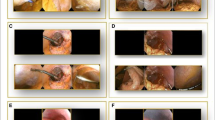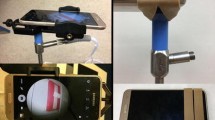Abstract
Laparoscopic surgery is the standard of care in high-income countries for many procedures in the chest and abdomen. It avoids large incisions by using a tiny camera and fine instruments manipulated through keyhole incisions, but it is generally unavailable in low- and middle-income countries (LMICs) due to the high cost of installment, lack of qualified maintenance personnel, unreliable electricity, and shortage of consumable items. Patients in LMICs would benefit from laparoscopic surgery, as advantages include decreased pain, improved recovery time, fewer wound infections, and shorter hospital stays. To address this need, we developed an accessible laparoscopic system, called the ReadyView laparoscope for use in LMICs. The device includes an integrated camera and LED light source that can be displayed on any monitor. The ReadyView laparoscope was evaluated with standard optical imaging targets to determine its performance against a state-of-the-art commercial laparoscope. The ReadyView laparoscope has a comparable resolving power, lens distortion, field of view, depth of field, and color reproduction accuracy to a commercially available endoscope, particularly at shorter, commonly-used working distances (3-5 cm). Additionally, the ReadyView has a cooler temperature profile, decreasing the risk for tissue injury and operating room fires. The ReadyView features a waterproof design, enabling sterilization by submersion, as commonly performed in LMICs. A custom desktop software was developed to view the video on a laptop computer with a frame rate greater than 30 frames per second and to white balance the image, which is critical for clinical use. The ReadyView laparoscope is capable of providing the image quality and overall performance needed for laparoscopic surgery. This portable low-cost system is well suited to increase access to laparoscopic surgery in LMICs.











Similar content being viewed by others
References
Aoki, H., H. Yamashita, T. Mori, T. Fukuyo, and T. Chiba. Ultrahigh sensitivity endoscopic camera using a new CMOS image sensor: providing with clear images under low illumination in addition to fluorescent images. Surg. Endosc. 28:3240–3248, 2014.
Baiu, I., and B. C. Visser. Minimally invasive small bowel cancer surgery. Surg. Oncol. Clin. N. Am. 28:273–283, 2019.
Bhangu, A., et al. Surgical site infection after gastrointestinal surgery in high-income, middle-income, and low-income countries: a prospective, international, multicentre cohort study. Lancet Infect. Dis. 18:516–525, 2018.
Bharathi, R. S., V. Sharma, A. Chakladar, and P. Kumari. Performing laparoscopic cholecystectomy using diagnostic laparoscope: our Adaptations. Med. J. Armed Forces India 67:64–66, 2011.
Brooks, D. C. Current Review of Minimally Invasive Surgery. New York: Springer, pp. 54–56, 1998.
Cappell, M. S. Injury to endoscopic personnel from tripping over exposed cords, wires, and tubing in the endoscopy suite: a preventable cause of potentially severe workplace injury. Dig. Dis. Sci. 55:947–951, 2010.
Cassaro, S. Delayed manifestations of laparoscopic bowel injury. Am. Surg. 81:478–482, 2015.
Committee, N. T. S. Report and Reports of Panel No. 11, 11-A, 12-19, with Some supplementary references cited in the Reports, and the Petition for adoption of transmission standards for color television before the Federal Communications Commission. (1953).
Cotton, P. B. Advanced Digestive Endoscopy: Practice and Safety. Hoboken: Blackwell, 2009.
Drake, T. M., et al. Laparoscopy in management of appendicitis in high-, middle-, and low-income countries: a multicenter, prospective, cohort study. Surg. Endosc. 32:3450–3466, 2018.
Duchemann, B., and L. Zelek. Cancer treatment. Surgery, radiotherapy, medical treatments (chemotherapy, targeted therapies, immunotherapy). Multidisciplinary therapeutic decision and patient information. Rev. Prat. 67:e499–e509, 2017.
Farquharson, D. V., P. Jaramillo, and C. Samaras. Sustainability implications of electricity outages in sub-Saharan Africa. Nat. Sustain. 1:589–597, 2018.
Fleischer, J. C., J. C. Diehl, L. S. G. L. Wauben, and J. Dankelman. The effect of chemical cleaning on mechanical properties of Tthree-dimensional printed polylactic acid. J. Med. Device. 14:1–9, 2020.
Fogg, D. Cleaning endoscopes; advance medication preparation; reusing irrigation setups; procedure masks; fire safety; reusing blades. AORN J. 78:839–844, 2003.
Gheza, F., F. O. Oginni, S. Crivellaro, M. A. Masrur, and A. O. Adisa. Affordable laparoscopic camera system (ALCS) designed for low- and middle-income countries: a feasibility study. World J. Surg. 42:3501–3507, 2018.
Groen, R. S., V. M. Sriram, T. B. Kamara, A. L. Kushner, and L. Blok. Individual and community perceptions of surgical care in sierra leone. Trop. Med. Int. Heal. 19:107–116, 2014.
Higgins, R. M., M. J. Frelich, M. E. Bosler, and J. C. Gould. Cost analysis of robotic versus laparoscopic general surgery procedures. Surg. Endosc. 31:185–192, 2017.
Hugo, W. B. A brief history of heat and chemical preservation and disinfection. J. Appl. Bacteriol. 71:9–18, 1991.
International Electrotechnical Commission. Medical electrical equipment-Part 1: General requirements for basic safety and essential performance. (2012).
Janhofer, D. E., C. Lakhiani, and D. H. Song. Addressing surgeon fatigue: current understanding and strategies for mitigation. Plast. Reconstr. Surg. 144:693e–699e, 2019.
Jawale, S., and G. Jesudian. Low-cost laparoscopy for rural areas: the flexible video laparoscope. Trop. Doct. 49:68–70, 2019.
Storz, K. Innovative by Technology. (2018).
Koren, N. The Imatest program: comparing cameras with different amounts of sharpening. In Digital Photography II (eds. Sampat, N., DiCarlo, J. M. & Martin, R. A.) 6069, 60690L (SPIE, 2006).
Lam, C. T., et al. Design of a novel low cost point of care tampon (POCkeT) colposcope for use in resource limited settings. PLoS ONE 10:1–22, 2015.
Lam, C. T., et al. An integrated strategy for improving contrast, durability, and portability of a Pocket Colposcope for cervical cancer screening and diagnosis. PLoS ONE 13:1–20, 2018.
Li, W., M. Soto-Thompson, and U. Gustafsson. A new image calibration system in digital colposcopy. Opt. Express 14:12887, 2006.
Lombardo, S., et al. Cost and outcomes of open versus laparoscopic cholecystectomy in Mongolia. J. Surg. Res. 229:186–191, 2018.
Meyer, M.-P., and P. Read. Restoration of Motion Picture Film - Paul Read. Oxford: Mark-Paul Meyer. Butterworth Heinemann, 2000.
Murray, A., et al. Clinical effectiveness and cost-effectiveness of laparoscopic surgery for colorectal cancer: systematic reviews. Health Technol. Assess. 2006(10):1–144, 2006.
Muzira, A., et al. The socioeconomic impact of a pediatric ostomy in Uganda: a pilot study. Pediatr. Surg. Int. 34:457–466, 2018.
O’Hara, N. N., K. R. Patel, A. Caldwell, S. Shone, and E. A. Bryce. Sterile reprocessing of surgical instruments in low- and middle-income countries: a multicenter pilot study. Am. J. Infect. Control 43:1197–1200, 2015.
Oosting, R. M., L. S. G. L. Wauben, R. S. Groen, and J. Dankelman. Equipment for essential surgical care in 9 countries across Africa: availability, barriers and need for novel design. Health Technol. (Berl) 9:269–275, 2019.
Ramsay, C., et al. Systematic review and economic modelling of the relative clinical benefit and cost-effectiveness of laparoscopic surgery and robotic surgery for removal of the prostate in men with localised prostate cancer. Health Technol. Assess. 16:1–313, 2012.
Roumm, A. R., L. Pizzi, N. I. Goldfarb, and H. Cohn. Minimally invasive: minimally reimbursed? An examination of six laparoscopic surgical procedures. Surg. Innov. 12:261–287, 2005.
Schwartz, M., C. J. Jeng, and L. T. Chuang. Laparoscopic surgery for gynecologic cancer in low- and middle-income countries (LMICs): an area of need. Gynecol. Oncol. Reports 20:100–102, 2017.
Sood, H. S., M. Arya, H. Maple, P. Grange, and A. Haq. Robotic telemanipulating surgical systems for laparoscopy: the story so far in the UK. Expert Rev. Med. Devices 7:745–752, 2010.
Trouiller, P., et al. Drug development for neglected diseases: a deficient market and a public-health policy failure. Lancet 359:2188–2194, 2002.
Wang, Q., Desai, V. N., Ngo, Y. Z., Cheng, W.-C. & Pfefer, J. Towards standardized assessment of endoscope optical performance: geometric distortion. 2013 Int. Conf. Opt. Instruments Technol. Opt. Syst. Mod. Optoelectron. Instruments 9042, 904205 (2013).
Yavuz, Y., J. G. Skogås, M. G. Güllüoglu, T. Lango, and R. Marvik. Are cold light sources really cold? Surg. Laparosc. Endosc. Percutaneous Tech. 16:370–376, 2006.
Acknowledgements
This work was supported by a Bass Connections grant at Duke University and a Duke/Duke-NUS pilot project grant. JLM and NM work with the Calla Health Foundation.
Author information
Authors and Affiliations
Contributions
NR and JLM performed device development and testing, and drafting of the manuscript. EDS, CS, AB, BK, AG, SK, and MB all assisted in device development and testing. JLM, NR, and TNF created the project, obtained project funding and drafted the manuscript.
Corresponding author
Ethics declarations
Disclosures
JLM, AG and TNF have a patents pending related to this work. NR, EDS, CS, AB, BK, SK, and MB have nothing to disclose.
Additional information
Associate Editor Jane Grande-Allen oversaw the review of this article.
Publisher's Note
Springer Nature remains neutral with regard to jurisdictional claims in published maps and institutional affiliations.
Rights and permissions
About this article
Cite this article
Mueller, J.L., Rozman, N., Sunassee, E.D. et al. An Accessible Laparoscope for Surgery in Low- and Middle- Income Countries. Ann Biomed Eng 49, 1657–1669 (2021). https://doi.org/10.1007/s10439-020-02707-6
Received:
Accepted:
Published:
Issue Date:
DOI: https://doi.org/10.1007/s10439-020-02707-6




